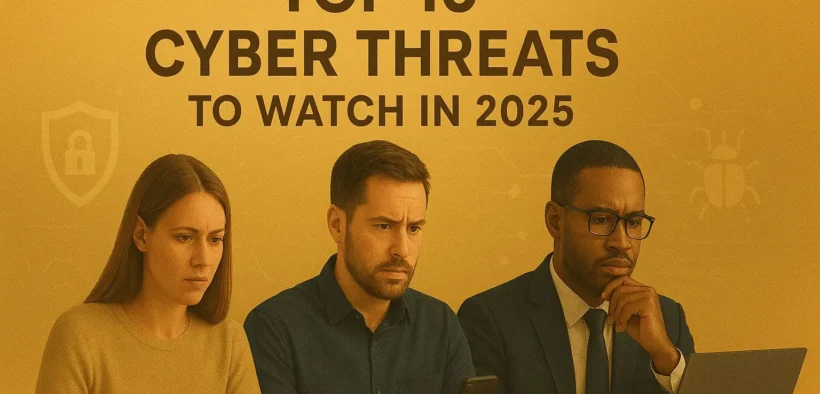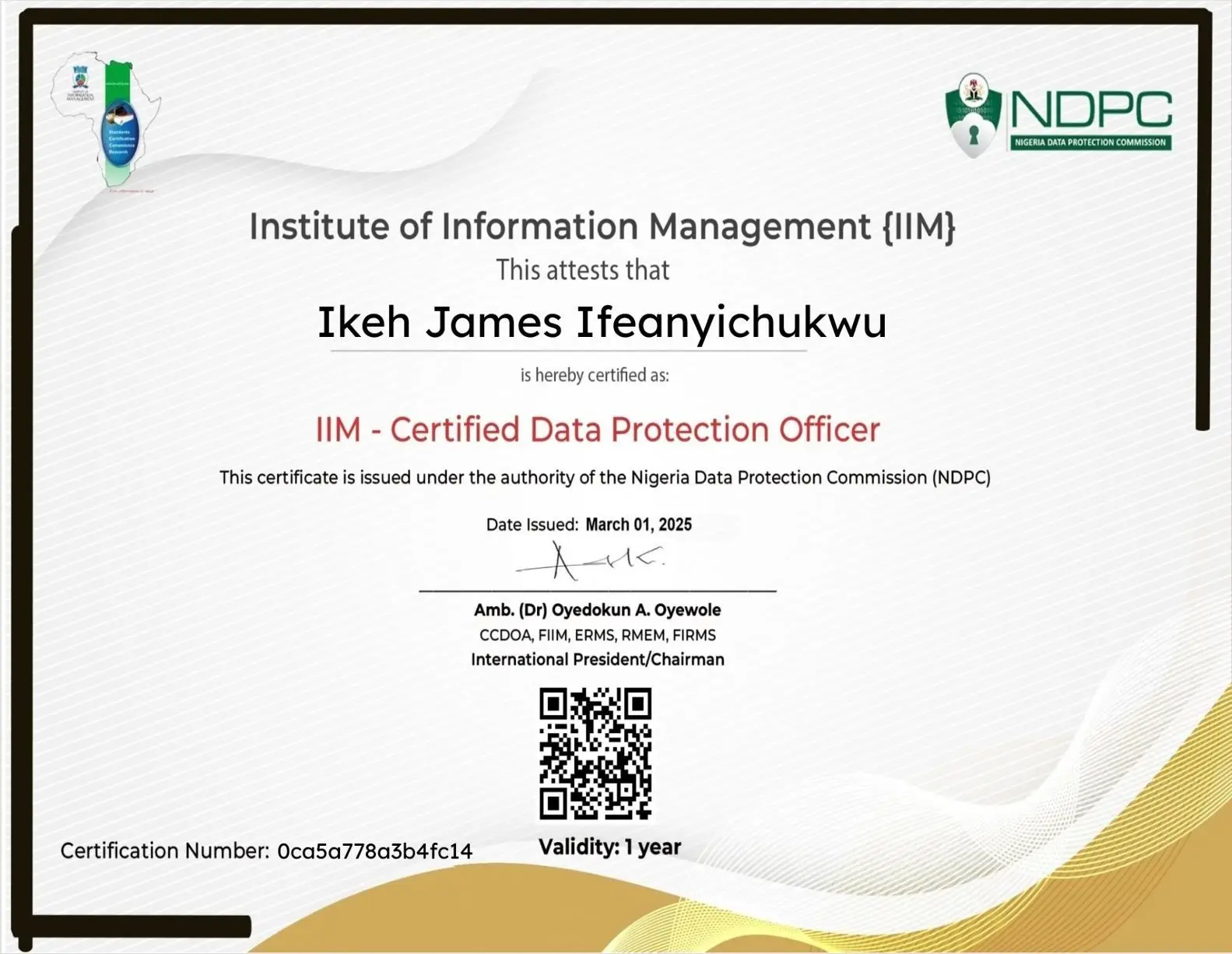The 2025 Cybersecurity Crisis: Top 10 Cyber Threats You Can’t Ignore
Share

Cybercrime isn’t slowing down — it’s accelerating. By 2025, global cybercrime costs are projected to hit $10.5 trillion annually (Cybersecurity Ventures). Businesses of all sizes, from SMEs to Fortune 500 giants, are facing increasingly sophisticated, AI-powered, and globalized cyber threats.
This article explores the Top 10 Cyber Threats to Watch in 2025, backed by expert analysis, real-world examples, and practical defense strategies.
1. AI-Powered Cyber Attacks
Artificial Intelligence is a double-edged sword. While it strengthens defense systems, it also fuels hyper-personalized phishing campaigns, automated hacking, and adaptive malware.
Example: In 2024, researchers demonstrated how AI chatbots could generate realistic phishing emails at scale, bypassing traditional filters. By 2025, attackers are expected to integrate generative AI into voice phishing (vishing) and deepfake scams.
How to Defend:
- Implement AI-driven threat detection tools.
- Train employees to spot deepfake and AI-generated scams.
- Use multi-factor authentication (MFA) everywhere.
2. Ransomware-as-a-Service (RaaS) Expansion
Ransomware groups are shifting to a subscription model, offering “attack kits” to anyone willing to pay. This lowers the barrier for entry, meaning even non-technical criminals can launch ransomware attacks.
Example: The LockBit group has been linked to global attacks on healthcare, education, and manufacturing. By 2025, RaaS will become as widespread as SaaS (Software-as-a-Service).
How to Defend:
- Maintain regular, offline backups.
- Segment networks to limit damage.
- Implement Zero Trust security frameworks.
3. Deepfake-Driven Social Engineering
Deepfake videos and AI-generated voices are turning CEO fraud and business email compromise (BEC) into business video compromise (BVC).
Example: In 2024, a UK-based company lost $243,000 after an employee was tricked by a deepfake video call of their CFO. Expect this to escalate in 2025.
How to Defend:
- Verify unusual requests via secondary channels.
- Adopt video authentication tools.
- Train employees on emerging deepfake risks.
4. Cloud Security Threats
As remote and hybrid work expand, cloud misconfigurations and insider threats are becoming major attack vectors. Attackers exploit poorly secured storage buckets, weak IAM (Identity & Access Management), and third-party SaaS integrations.
How to Defend:
- Use cloud-native security platforms.
- Regularly audit configurations.
- Enforce strong IAM controls.
5. IoT (Internet of Things) Vulnerabilities
By 2025, the number of IoT devices will exceed 30 billion worldwide. From smart home devices to industrial IoT, attackers are targeting unpatched sensors, cameras, and routers to infiltrate larger systems.
Example: The Mirai botnet exploited insecure IoT devices to launch record-breaking DDoS attacks. Modern versions are even more sophisticated.
How to Defend:
- Change default IoT passwords.
- Keep firmware updated.
- Segment IoT devices from critical systems.
6. Supply Chain Attacks
Hackers increasingly target vendors, contractors, and third-party software providers to infiltrate larger organizations.
Example: The SolarWinds hack showed how one compromised vendor could affect thousands of global enterprises. Similar large-scale incidents are expected in 2025.
How to Defend:
- Vet vendors’ cybersecurity practices.
- Apply third-party risk management frameworks.
- Monitor software supply chains continuously.
7. State-Sponsored Cyber Warfare
Geopolitical tensions (US-China, Russia-Ukraine, Middle East conflicts) are fueling nation-state cyberattacks on critical infrastructure like energy grids, transportation, and finance systems.
Example: In 2023, Microsoft warned of Chinese hackers targeting US critical infrastructure. By 2025, such incidents will grow in frequency and sophistication.
How to Defend:
- Strengthen critical infrastructure resilience.
- Collaborate with government cybersecurity agencies.
- Conduct cyber war game simulations.
8. Data Privacy Breaches & Regulatory Risks
With stricter laws like the GDPR, CPRA, and Nigeria’s NDPA, data breaches now carry hefty financial and reputational costs. Hackers exploit weak data management, while regulators impose heavy fines.
Example: Meta was fined €1.2 billion under GDPR in 2023 for unlawful data transfers.
How to Defend:
- Minimize data collection.
- Encrypt all sensitive data.
- Maintain compliance with privacy regulations.
9. Insider Threats
Employees, contractors, or disgruntled staff remain one of the most unpredictable risks. Insiders may leak data, sell credentials, or unknowingly aid cybercriminals.
How to Defend:
- Monitor user behavior with UEBA (User & Entity Behavior Analytics).
- Implement role-based access control (RBAC).
- Conduct ongoing employee awareness programs.
10. Quantum Computing Threats
While quantum computing promises breakthroughs, it also threatens to break current encryption methods. Hackers with access to quantum tech could decrypt sensitive data in minutes.
How to Defend:
- Begin transitioning to post-quantum cryptography.
- Follow NIST’s upcoming quantum-safe standards.
- Plan long-term encryption upgrades.
Summary Table: Top 10 Cyber Threats in 2025
| Threat | Key Risk | Example | Defense Strategy |
|---|---|---|---|
| AI-Powered Attacks | Automated phishing & malware | AI chatbots creating phishing emails | AI threat detection, MFA |
| Ransomware-as-a-Service | Subscription-based ransomware | LockBit group attacks | Offline backups, Zero Trust |
| Deepfakes | Fake videos/voices for fraud | CFO deepfake scam | Verification channels |
| Cloud Security | Misconfigurations, SaaS risks | Leaky AWS S3 buckets | Cloud audits, IAM controls |
| IoT Vulnerabilities | Device takeovers, botnets | Mirai botnet | Patch devices, segmentation |
| Supply Chain Attacks | Vendor exploitation | SolarWinds hack | Vendor risk management |
| State-Sponsored Attacks | Infrastructure sabotage | Chinese hacks on US power grid | Gov’t collaboration |
| Data Privacy Breaches | Regulatory fines | Meta €1.2B GDPR fine | Encryption, compliance |
| Insider Threats | Credential leaks | Employees selling access | UEBA, RBAC |
| Quantum Threats | Encryption breakage | Future risk scenario | Post-quantum cryptography |
FAQs
1. What is the biggest cyber threat in 2025?
AI-powered cyber attacks and ransomware are expected to dominate, given their scalability and profitability for attackers.
2. Which industries are most at risk?
Healthcare, finance, critical infrastructure, and SMEs (small and medium enterprises) are top targets.
3. How can businesses prepare?
Adopt Zero Trust models, invest in cyber awareness training, and stay updated on regulatory compliance.
4. Will quantum computing really break encryption?
Not immediately in 2025, but businesses should start preparing by exploring quantum-safe encryption methods.
5. What’s the role of employees in preventing cyber threats?
Human error drives over 80% of breaches (IBM 2024). Training employees to spot threats is as critical as using advanced tech tools.
Conclusion
2025 won’t just be another year in cybersecurity — it will be a turning point. AI-driven attacks, deepfake scams, and ransomware will test every organization’s resilience. The good news? With proactive defenses, smart risk management, and employee awareness, businesses can stay ahead of hackers.
Cybersecurity in 2025 is less about tools and more about strategy, awareness, and continuous adaptation. The threats are evolving — but so can your defenses.


























Leave a Reply